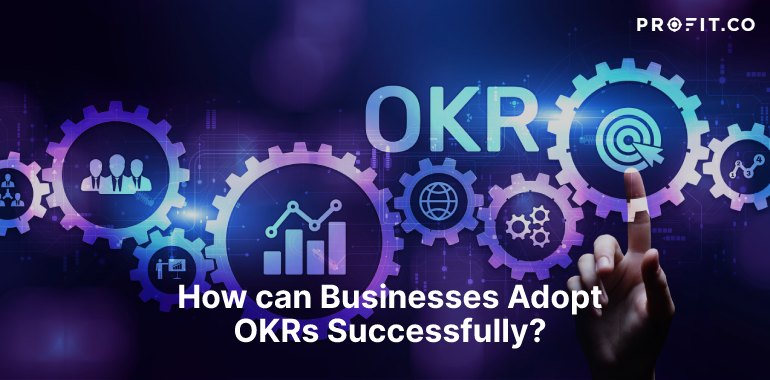Many experts say that software contributes to roughly 20-25% of the overall OKR program’s success. There are many other factors that determine the successful rollout of any OKR Program. In fact, many suggest you start with spreadsheets and then you’ll realize when you need software.
When we engage with clients we see this to be 100% true. We also realized that if the OKR program fails for any reason, most of the blame falls on the software. So, if clients have a background in OKR and then adopt Profit.co, we usually have very high retention rates.
When we talk about getting businesses to implement OKRs successfully, we have found out that it’s very important to look at each situation from 2 perspectives:
- OKR Knowledge of the Organization
- Willingness to invest in and learn best practices
To put this in perspective, we can create a 2 X 2 with OKR knowledge in the X axis and Willingness to invest in best practices on the Y axis.
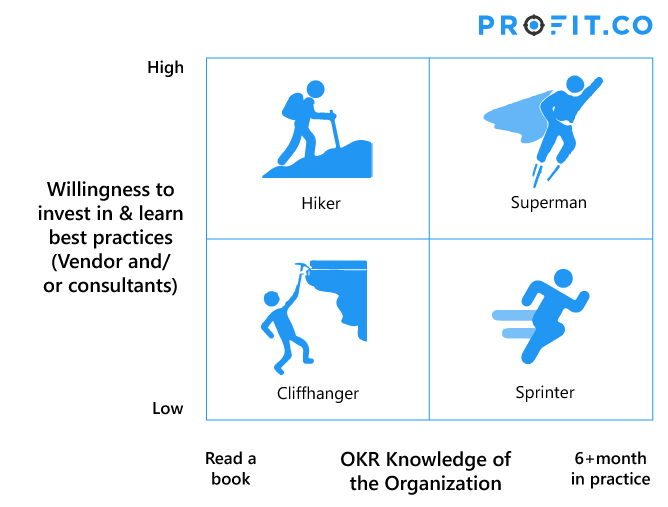
OKR knowledge of the organization goes from “read a book” to 6+ months of practice. 6+ months of practice using spreadsheets or powerpoint is actually considered pretty good. We are not going to pretend that, 6+months of experience is going to make you a superstar or an expert yet, but you know your way around the basics and can navigate through that methodology comfortably.
Willingness to invest in best practices is mostly about spending money on consultants who can teach you want to do, and more importantly what not to do. When it comes to listening to best practices advice from both consultants and Profit.co, we have had situations where key stakeholders just ignore and sometimes ridicule the suggestions. One of those frequently ridiculed points is on OKR Scoring and interpretations. So, this is a factor. On one end, we have low willingness. And on the other end we have high willingness.
Q1: Cliffhanger Quadrant
So if you are in this bottom left quadrant, where your willingness is low to kind of medium. And then you’ve just read a book. This is what we would call a cliffhanger situation.

We really, really cannot do much. It’s kind of like, “Okay, we don’t know much about OKR, but we are also not going to listen to anyone situation.” And you got to trust us, we’ve seen clients who are in this quadrant and, for some reason or the other, we have to kind of like figure out how to work with, identify probably sweet spots in terms of people who are open to kind of listening and trying to go through, right? That actually happens a little bit, it’s not a huge proportion of what we see in practice.
The important point to stress here is that, if you feel that you are in this quadrant you should try very hard to move the one up above, that is discussed next.
Q2: Hiker Quadrant
In this quadrant, the current OKR knowledge level is low, but they are willing to listen. We feel very encouraged when clients come and say, “Hey, we really need some help and we would gladly invest some reasonable amount up-front and learn from consultants. Can you just give us some good advice on who would be the best consultants or if you’re able to do it, what would you really do? How would you really engage?”
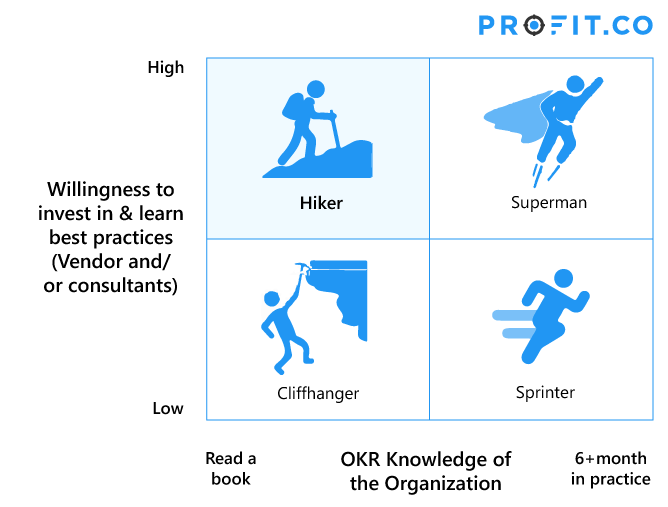
We listen to them, understand their level of expertise and assess what kind of help they’ll need. We work with several industry veterans and based on what we believe as the right fit, we refer consulting partners, but we fee super obligated to stay extremely engaged to ensure that the implementation and rollout are successful. Good consulting help is not cheap. These consultants are always in high demand. So, if for some reason expert consulting help is not affordable for the client, we take the role of the expert consultant and help them out. This works out pretty well, as long as the client is firmly in the top left quadrant.
In both cases where we’ve referred to other consultants, as well as us helping customers with best practices, it has worked out really well because of primarily their willingness to listen to us more than anything else. They know that. “Hey, we need help. We are not going to pretend like we are experts, just tell us what to do, tell us what works and what doesn’t.” This is great from our standpoint. We walk through the process step-by-step, help them with setting up corporate OKR, setting up department OKRs, and then the sub department and so on. And then in about 1-2 quarters, they are at a point where they are able to kind of take it and move forward themselves.
Q3: Sprinter Quadrant
The bottom right quadrant is the third quarter where we have people’s willingness to listen is low, but they have already got good practice, and good knowledge themselves. So they’re kind of warmed up already and ready for the race.
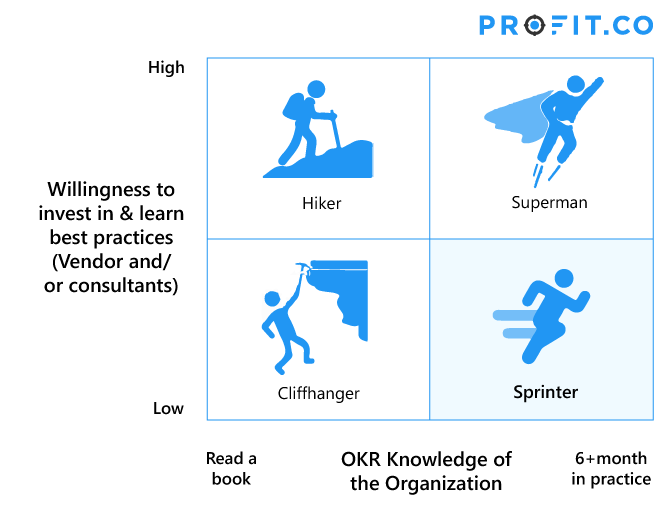
They are not arrogant, when they have this “low” willingness to learn best practices. They just feel confident about their current process. They’re really not worried about best practices, because they have first hand experience on what worked and what didn’t and have committed themselves to the methodology. It’s mostly a software selection problem for them. Even though their willingness to listen to you is less, because of their inherent knowledge of the practice and methodology, they decide what to do and what features to turn off, what features to enable in the initial phase. And quite frankly, they actually give us a lot of good guidance on making certain things more usable, friendly, and so on and so forth. So we really enjoy working with customers in this quadrant.
Q4: Superman Quadrant
The fourth quadrant is the “delight” quadrant for us. When somebody is in this quadrant, they’ve got very good practice and they’re also willing to listen to us, that’s an absolute, delightful situation for both of us, which is why we call this as the superman situation for us, as well as them.
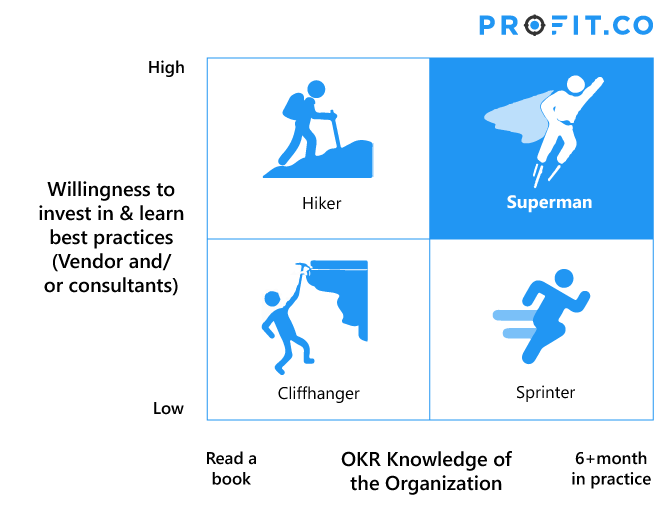
They’ll really be flying. They’ll really be flying super fast and will get the benefits of the product as well as the methodology, a lot faster. This is an ideal place to be.
In summary, it is really hard to make implementations for prospects/customers who are in the “Cliffhanger” quadrant work. Unless we do a good job with account management and set good expectations to move them to the top left which is the “Slow hike” quadrant, we know that we could fall off the cliff any moment. Customers in Q3, the “Ready to Sprint” quadrant are good to work with, but those in Q4, the superman quadrant are an absolute delight to work with.



